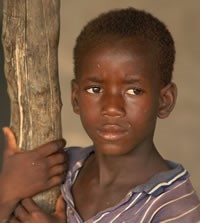The various Senoufo groups live in the Middle Volta region of West Africa which includes parts of Cote d'Ivoire, Mali, and Burkina Faso. They are divided into three groups: Northern, Central, and Southern, according to the three distinct language divisions. As a whole, the Senoufo tribes speak over thirty dialects.
In the 1700s, Dyula traders settled among the Southern Senoufo. They eventually overpowered the Senoufo and raised up their own rulers. Kong became their Islamic capital, but Islam was once again limited to the elite.
Most Senoufo are subsistence farmers. They have been admired as skilled agriculturists, cultivating dry rice, yams, peanuts, and millet in the grasslands that are prevalent in their region. One of the most important ways for a male to gain prestige is to become a sambali, which is a "champion cultivator." A sambali is respected throughout his lifetime and upholds the honor of his residential settlement before the entire village and surrounding district.
One important aspect of Senoufo society is its concept of "community." The Senoufo think of themselves as one group, with all of their ideas pointing in the same direction. The concept of the "individual" is known only in limited circumstances; thus, no man stands alone. Instead, each person is thought of as part of an extended family, a member of the village, the elder or younger brother, etc. Everyone eats as a group and dips into a common dish. The fields are worked collectively, food is stored collectively, and each family contributes to the village. A Senoufo is always aware of his place in the society as it relates to others in the group. To the Senoufo, the good of the community always comes before the good of the individual. Unless the entire tribe makes a change, such as converting to a different religion, no one does.
Another important feature of Senoufo life is the poro or "male secret society." The poro prepares men for leadership in the community, so that they might attain wisdom, accept responsibility and gain power. It begins with the child's grade of "discovery," followed by extensive training and service. It ends with the ritual death of the child and the final graduation of the "finished man." Dramatic ceremonies, dances, and visual displays mark the passage from one grade to the next. When the man reaches about 30 years of age, the initiation is complete, and he is considered an adult. He then becomes one of the elders with whom the chief consults on major decisions. Poro sanctuaries are hidden inside dense groves of trees outside Senoufo villages. These sacred groves are used as schools, meeting houses and places of worship.
Since World War II, the Senoufo region has become more commercialized and urbanized. Today, the young men have opportunities to move to the cities and earn money. This has weakened the influences that Senoufo fathers formerly had over their sons. The importance of the communal nature of their society has also declined. Unfortunately, the weakening of these two areas has allowed Islam to begin seeping into the cracks of this rapidly changing society.
In Cote d'Ivoire, the Southern Senoufo can be Christian, Muslim or animistic. Most likely the coming decades will determine which way they will go spiritually.
Today, Senoufo society is rapidly changing. The Senoufo need an opportunity to hear the truth of the gospel before a total conversion to Islam takes place. There is a great need for intense prayers and increased evangelism efforts.
Ask the Lord to call people who are willing to go to Cote d'Ivoire and share Christ with the Southern Senoufo.
Pray that the Holy Spirit will soften the hearts of the Southern Senoufo towards the ways of Christ.
Ask the Lord to give the Senoufo believers courage to share the gospel with their own people.
Ask the Lord to raise up strong local fellowships of believers among each of the Senoufo tribes.
Scripture Prayers for the Senoufo, Southern in Côte d'Ivoire.
| Profile Source: Joshua Project |











